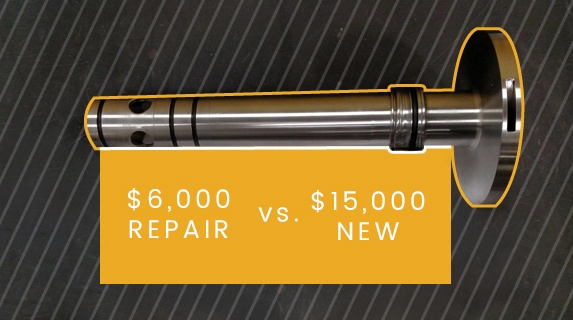Sometimes, something as simple as a plant visit can save a facility well over $15,000. Here’s how it happened.
It All Started with Two Pumps on the Floor
I was visiting a plant in the upper Midwest for what was a pretty routine visit. They already had a centrifuge service provider, and I was just coming in to talk with the maintenance manager about our capabilities and areas of expertise. After chatting for a bit, I got up to shake his hand and noticed two pumps on the floor. They were the upper and lower centripetal pumps from one of his centrifuges. So, I had to ask:
“What are you doing with those pumps?”
“They’re headed up to scrap.”
“Really? What’s wrong with them?”
“They’ve got some pitting, and they’re separating a little bit.”
“Would you be willing to let me take them back to Indy with me and we can get you an estimate for how much it’ll cost to repair them?”
“I didn’t know they could be repaired… I’m definitely open to that.”
Repairing vs. Replacing Centripetal Pumps
I took both pumps back to our Indianapolis facility and a couple days later shared our estimate with the maintenance manager. He gave us the go ahead, and we repaired both pumps to like-new condition for a total of $12,000. For comparison, the maintenance manager had recently purchased two new replacement pumps, which came in at about $15,000 each. That means we repaired both pumps for less than it cost to purchase one.
Since this repair took place after he had already replaced the pumps, these pumps are stored and ready to be rotated in the next time a set goes bad. Even though this happened recently, we've already worked with the same plant to repair a few more centripetal pumps, repair a spindle, and order some spare parts.
Pump Maintenance Checklist
At minimum, your centrifuge should receive maintenance every six months. At the six month mark, it should receive what's called a top end service, and at the one year mark, it should receive an annual.
These regular maintenance checks ensure the machine is kept in safe, working order. Here are some preventative measures that you can take to be proactive about your separation efficiency and extend the workable life of your machine(s):
Daily:
- Check overall sound level of the pump - loud noises may indicate a mechanical issue
- See that all electrical parts (motors, switches, etc.) are operating correctly
- Monitor temperature of pump bearing
- Check speed calibration
- Examine bearing vibration
- Check oil level and oil the fan motor
- Identify any leakage
- Examine alignment of pump with motor shaft and do checkup of screws
- Monitor operating pressure
- Check heating efficiency of pump
- Clean exterior and interior with a sponge, warm water, and mild detergent
As necessary:
- Check suction filter and clean
- Lubricate pump
- Look for residue and corrosion on the rotor, buckets, and spindle
Centrifugal Pump Parts & Function
Each centrifugal pump is made from hundreds of individual parts. Some of the most common components found in virtually every centrifugal pump are:
- Impeller - Rotor used to increase the kinetic energy of the flow. A properly working impeller optimizes flow and maximizes efficiency.
- Volute or diffuser casing - Contains the liquid and acts as a pressure containment vessel that directs the flow of liquid in and out of the centrifugal pump and slows down the rate of flow.
- Shaft (Rotor) - The impeller is mounted on a shaft, a mechanical component for transmitting torque from the motor to the impeller. Shafts must be sized carefully to increase pump life.
- Shaft sealing - Packing rings or a mechanical seal that helps prevent the leakage of the pumped liquid.
- Bearings - Constrain relative motion of the shaft and reduce friction between the rotating shaft and the stator.
If one of these parts breaks down or isn’t working properly, you must assess the issue quickly to avoid permanent damage.
Partner with Experience and Expertise
My experience with this plant was a good reminder that current and potential customers aren’t always aware of what we offer or what we can do for them. It’s pretty typical for a customer to be unaware of what can and can’t be repaired, which is why it’s good to partner with a provider who does specialize in these areas. That way, when needs or opportunities come up, they have a trusted partner who can advise them and look out for their best interests.
If you found this story interesting, know that this isn’t a once in a million kind of situation. This sort of thing happens more often than most would think. Instead of leaving money on the table, contact a Separators rep and see how much you can save.

